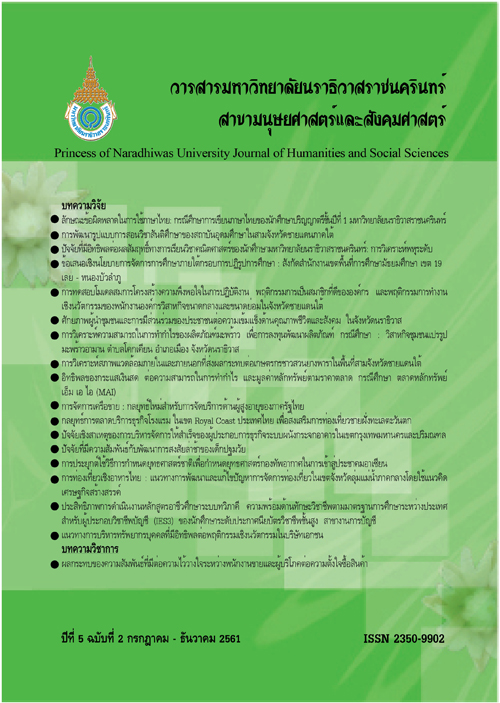แนวทางการบริหารทรัพยากรบุคคลที่มีอิทธิพลต่อพฤติกรรมเชิงนวัตกรรมในบริษัทเอกชน
Main Article Content
Abstract
The objectives of this mixed methods research were to 1. compare the differences of Innovative Behavior (IB) by personal factors of employees, 2. study human resource human resource management approach (HRMA) affect on IB, and 3. study the influence of HRMA affect on IB. Studying 6 companies. The study processes consisted of in-depth interviewing the executive and surveying, the samples were 403 employees. The instruments used in this study were researcher and questionnaire. Comparing the differences of employees’ IB by t-test, one way ANOVA, and LSD were used to compare the difference between groups. In-depth interview, Factor Analysis and Path Analysis had been done to analyze the affect and influence of HRMA on IB.
The research found that 1. employees with different gender, education, age and years of work experiences had different IB, as for the different work status, executive position and line staff had no different IB, 2. the important opinion of executives was the leaders must clearly assign subordinates to create innovation base on their needs. The 8 factors that reflect IB which consist of 1) organizational motivation 2) role model of leadership 3) counseling from supervisor 4) personal motivation 5) learning encouragement 6) organization recognize significance of IB 7) stimulation from supervisor 8) internal communication. These 8 factors can be described in the study of IB at 71.52 percent, and 3. gender, education, years of work experience, personal motivation, role model of leadership, stimulation from supervisor, organization recognize the innovation and internal communication directly influenced on IB, while age, organization motivation, counseling from supervisor and learning encouragement had indirectly influence on IB.
Article Details
References
Literature Review. Personnel Review, 46(7), 1228-1253.
2.Cleviton, V. F., Fabio, Q. B., & Capretz, L. F. (2016). The Innovative Behaviour of Software Engineers: Findings
from a Pilot Case Study. 10th International Symposium on Empirical Software Engineering and
Measurement.
3.Cooper, J. (2006). The digital divide: The special case of gender. Journal of Computer Assisted Learning,
22(5), 320-334.
4.Hanif, A., & Bukhari, I. (2015). Relationship between Innovative Work Behavior and Job Involvement among
the Employees of Telecom Sector. Pakistan Journal of Social and Clinical Psychology, 13(2), 23-29
5.Ighomereho, S. O., Agbalajobi, D. T., & Edegwa, S. K. (2013). Gender Influence on Access to Innovation
Resources in Nigeria. International Journal of Humanities and Social Science, 3(1), 216-227.
6.Jeroen, P. J., & Deanne N. D. (2007). How Leaders Influence Employees Innovative Behaviour. European
Journal of Innovation Management , 10 (1), 41-64.
7.Krejcie, R. V., & Morgan, D. W. (1970). Determining Sample Size for Research Activities. Educational and
Psychological Measurement, 30, 607-610.
8.Li, X. Y., & Zheng, Y. S. (2014). The Influential Factors of Employee's Innovative Behavior and the Management
Advices. Journal of Service Science and Management, 7(6), 446-450.
9.Ministry of Economy, Trade and Industry Japan Innovation Network World Innovation Lab. (2016). Who is
Responsible for Creating Innovation in Companies?. Innovation 100 Committee Secretariat, 16.
10.Nijenhuis, K. (2015). Impact Factors for Innovative Work Behavior in The Public Sector; The Case of the
Dutch Fire Department. Retrieved 4 26, 2018, from University of Twente. http://essay.utwente.
nl/67809/1/Nijenhuis_MA_MB.pdf
11.Sanders, K., Moorkamp, M., Torka, N., Groeneveld, S., & Groeneveld, C. (2010). How to Support Innovative
Behaviour? The Role of LMX and Satisfaction with HR Practices. Technology and Investment, 1,
59-68.
12.Shamim, S., Cang, S., Yu, H., & Li, Y. (2016). Management Approaches for Industry 4.0: A Human Resource
Management Perspective. IEEE.


